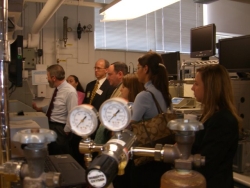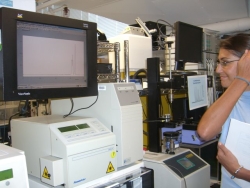Home > News and Events > NIBIB Newsletter
In This Issue
LinksNational Institute of Biomedical Imaging and Bioengineering (www.nibib.nih.gov) Contact UsScience HighlightsNew Adhesives for Damaged Joints Millions of people suffer from joint pain caused by damaged cartilage, the lubricating tissue found on the ends of bones in various places in the body, including joints. The main sources of cartilage damage are sports injuries and arthritis. In arthritis, joint cartilage permanently wastes away, making even simple movements very painful. For many patients, relief comes only from total joint replacement, a surgical procedure that carries risks, including blood clots and nerve injury. An alternative to total joint replacement is cartilage repair. Being slippery, cartilage is particularly difficult to repair. Jennifer Elisseeff, Associate Professor of Biomedical Engineering, and her research team at Johns Hopkins University are exploring new ways of bonding cartilage tissue. They have modified a natural sugar substance called chondroitin sulfate (CS) to enable it to “glue” a jellylike material called hydrogel to cartilage tissue. Hydrogels, such as the material soft contact lenses are made of, are ideally suited for tissue engineering because they integrate well with the body, support nutrient-waste exchange, and promote new tissue growth. These synthetic materials can also be infused with nutrients and cells. Elisseeff’s CS adhesive, which chemically connects hydrogel to cartilage, is simple to administer and is not harmful to the cartilage tissue. CS is an attractive choice for tissue repair due to its anti-inflammatory activity, improvement of wound healing, and ability to absorb nutrients and water—which accounts for up to 80% of cartilage mass. A clinical trial is under way. For more information about the use of CS adhesive in cartilage repair, please visit www.nibib.nih.gov/HealthEdu/eAdvances. Nonlinear Optical Microscopy: Advancing Diagnostics and Improving Treatments Nearly half a million people in the United States are living with spinal cord injury and another 400,000 are affected by multiple sclerosis (MS). These conditions are characterized by loss of myelin sheaths, a major component of a part of the nervous system called white matter. Like plastic coating around an electrical wire, myelin sheaths act as insulators, facilitating conduction of nerve impulses. Loss of myelin sheaths, termed demyelination, leads to a delay or blockage of neurological signals resulting in often-fatal impairments of movement, hearing, speech, or vision. The process of demyelination is poorly understood, in part due to an inability to image subcellular details in intact white matter. Recently, Ji-Xin Cheng, Assistant Professor of Biomedical Engineering and Chemistry at Purdue University, identified some crucial roles of calcium and glutamate in triggering demyelination. These findings will aid researchers in understanding nerve damage and could promote better treatment of diseases such as MS. The discovery of these triggers was made using a novel imaging technique called Coherent anti-Stokes Raman scattering (CARS) microscopy. CARS is one of several nonlinear optical (NLO) techniques that have recently emerged as unparalleled tools for high-resolution imaging of living tissues. In addition to utilizing CARS microscopy, researchers at Purdue have integrated two other NLO imaging modalities—two-photon excitation fluorescence (TPEF) and sum frequency generation (SFG)—on a CARS microscope, which they termed multimodal multiphoton microscopy (MMM). The group has utilized MMM to visualize live spinal cord and sciatic nerve in 3D and examine tumors in the body without the need for biopsies. For more information about NLO imaging, please visit www.nibib.nih.gov/HealthEdu/eAdvances/28Dec07. NIBIB NewsNIBIB Welcomes Three Council Members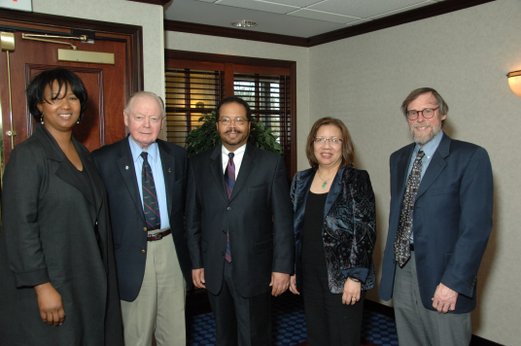 Mae Jemison, Percival McCormack, NIBIB Director Roderic Pettigrew, NIBIB Deputy Director Belinda Seto, and Gary Glover
Three new members were recently named to the National Advisory Council for Biomedical Imaging and Bioengineering. They are: Beating the Odds: Preparing Minorities for Research Careers in Science and Engineering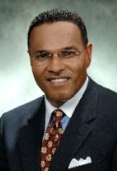 On January 25, Dr. Freeman A. Hrabowski III, President of the University of Maryland Baltimore County (UMBC), spoke at a meeting of the National Advisory Council for Biomedical Imaging and Bioengineering about his institution’s strategies for increasing minority representation in science and engineering research fields. The passion of his message is one of the many reasons why the UMBC campus has been so successful in its endeavor to inspire minority students to strive for new academic challenges, and to devote themselves to the arduous preparation necessary in career fields where few minority role models light the way. At UMBC, Hrabowski sets the academic and professional bar just as high for students as he does for himself. Although one might predict students would turn and run from such lofty goals, as his expectations have risen, so have UMBC statistical success rates, which have placed his university proudly in the academic spotlight. Hrabowski reveals secrets of his scouting campaign: “What we look for is fire in the belly and resilience. We want those who are prepared to really push to be the best.” As both Vice Provost and President of the predominantly white campus of 12,000 students, Hrabowski has been passionately driven to tap the energies of the whole melting pot of American brainpower. He tells the story of a man named Bouchet who received a doctoral degree from Yale University in 1876. He was the first black man in the United States to receive a Ph.D. Hrabowski adds, “The sad part is, [Bouchet] never had a chance to be a physicist because no one would hire him. Imagine what he might have been able to do if he had the opportunity to practice physics.” Although things have changed a lot since Bouchet’s time, contemporary American society continues to struggle to utilize the full potential of its citizens. Data on minorities in higher education reveal that only 20 years ago, there were no universities producing significant numbers of minority students prepared for graduate school in science and engineering. Subsequently in 1988, Hrabowski and others at UMBC responded by developing the Meyerhoff Scholars Program, which provides resources—financial, personal, and social—to science and engineering students who aspire to academic and professional excellence. The NIBIB, in partnership with the National Science Foundation, supports the Meyerhoff Scholarship Program through the Louis Stokes Alliances for Minority Participation (LSAMP) program, which provides scholarships to minority undergraduates at UMBC who are interested in pursuing doctoral study in science, technology, engineering, or mathematics (STEM). The ultimate aim of the LSAMP program is to help institutions with significant enrollments of underrepresented minority populations build their capacity for output of professionals in STEM fields. At its heart, LSAMP improves basic access for minority students by increasing the potential number of minority students interested in, academically qualified for, and matriculated into programs of graduate study in STEM fields. Giving historical perspective, Hrabowski says, “In the early years, I intentionally kept [the program] small. My vision has consistently been to produce students who will not simply be prepared in science, but who will be among the best.” In his grade book, simply passing is not good enough, and Meyerhoff students who receive a C grade or below are strongly encouraged to retake those courses. Hrabowski says he is “inspired by people of Asian descent” and explains that today, broader national statistics indicate that while 55 percent of Asian students go on to complete college degrees, only 17 percent of Black, one-third of Caucasian, and 11 percent of Hispanic students graduate from college. UMBC’s Meyerhoff Scholars Program helps students overcome their unique challenges by focusing on positive cultural differences, nurturing successful parenting strategies, providing supportive peer interaction opportunities, bolstering financial resources, and fighting stereotypical societal expectations. This support plays a big part in students’ ability to visualize and claim academic and professional destinies outside the norm for their particular racial or cultural group. Hrabowski reports that, major Asian groups aside, top positions at research universities, and in the science and engineering industries, are filled by less than two percent minorities, and many universities in the U.S. have not yet employed their first "person of color" in the sciences. Hrabowski believes Meyerhoff students’ academic experience, no matter what their background, will nurture a broader understanding and enrich their ultimate contributions to society. He says, “They will be treasures. How many… in undergraduate school have the chance to think about the challenges of poor people and underrepresented minorities?” Currently, 250 students are participating in the Meyerhoff Scholars Program, with two-thirds representing minority populations. UMBC’s efforts are yielding promising results—86 percent of Meyerhoff students graduate with degrees in science or engineering.1 With a high priority on producing Ph.D.-level researchers, UMBC also boasts the successful graduation of Meyerhoff students with advanced degrees: 44 with Ph.D.s or M.D./Ph.D.s, 72 with masters degrees, and 32 with medical degrees.1 According to Hrabowski, “There are years when UMBC students represent about one-third of the African-American students who are interviewed for M.D./Ph.D. programs.” Hrabowski acknowledges that education is a continuum that can only be optimized with proper social, parental, peer, and teaching infrastructure during a child’s earliest academic years. Despite the challenges, he is hopeful for those who engage themselves early enough in the undergraduate endeavor. He says, “Lack of preparation is something we have to work on in K-12. But I really believe it’s true that if we can do a better job with the undergraduates we get from all races, we will see a substantial increase in American students interested in continuing in science and engineering.” 1Summers MF, Hrabowski FA. Preparing minority scientists and engineers. Science. 2006 Mar 31;311:1870-1. Congressional Health Care Staff Tour NIBIB Intramural Laboratory
Optical Imaging Program Progress Review Report AvailableNIBIB recently completed the Institute’s first program progress review of the Optical Imaging program. The purpose of this progress review was to assess the state of the science, establish a baseline from which to measure progress, and determine future directions. The reviewers assessed the current optical imaging portfolio and discussed scientific opportunities and challenges. The full report is available online at www.nibib.nih.gov/nibib/File/Research/Optical Imaging PPR.pdf. Funding Opportunities & UpdatesPAR-08-023 - Predictive Multiscale Models of the Physiome in Health and Disease (R01)The goal of this solicitation is to move the field of biomedical computational modeling forward through the development of more realistic and predictive models of health and disease. The full program announcement is available at grants.nih.gov/grants/guide/pa-files/PAR-08-023.html. PAR-06-504 - Enabling Technologies for Tissue Engineering and Regenerative Medicine (R01)The goal of this announcement is to solicit research applications to promote the development of innovative technologies, tools, methods, and devices that will enable tissue engineering and regenerative medicine. The full program announcement is available at grants.nih.gov/grants/guide/pa-files/PAR-06-504.html. NIH Roadmap for Medical ResearchThe NIH Roadmap is a series of far-reaching initiatives designed to build on the progress in medical research achieved through the doubling of the NIH budget. NIBIB plays a significant role in Roadmap activities in many areas. More information on current NIH Roadmap funding opportunities is available at nihroadmap.nih.gov/grants/index.asp. NIH Blueprint for Neuroscience ResearchThe NIH Blueprint for Neuroscience Research is a cooperative effort among the 16 NIH Institutes, Centers, and Offices that support neuroscience research. By pooling resources and expertise, the Blueprint supports the development of new tools, training opportunities, and other resources to assist neuroscientists in both basic and clinical research. More information on current NIH Blueprint funding opportunities is available at neuroscienceblueprint.nih.gov/blueprint_funding/index.htm. Names in the NewsNew Faces at NIBIBMs. Eunica Haynes has joined the NIBIB Grants Management Office. AwardsArenson Named to RSNA Board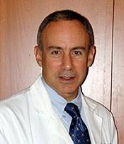 Ronald L. Arenson, M.D., a member of the NIBIB Advisory Council, has been elected as the newest member of the Radiological Society of North America (RSNA) Board of Directors. Dr. Arenson is an expert in radiology informatics, workforce issues, and the effect of managed care on radiology.
Woolley Receives Presidential Early Career Award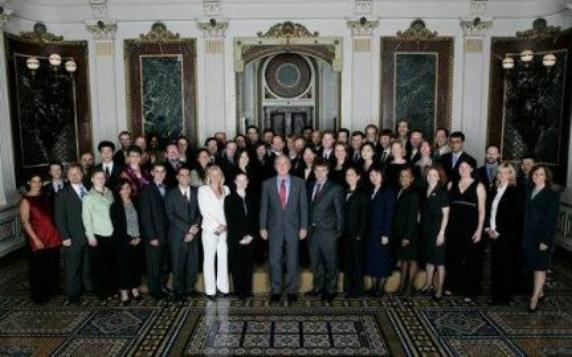 President Bush and the PECASE recipients
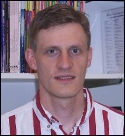 Adam T. Woolley, Ph.D., Professor of Chemistry and Biochemistry at Brigham Young University, is one of 59 researchers to recently receive the Presidential Early Career Award for Scientists and Engineers (PECASE). PECASE is the Nation’s highest honor for professionals at the outset of their independent scientific research careers. Dr. Woolley received his award at a White House ceremony in November. His research focuses on constructing polymeric microfluidic systems for fabrication of low-cost devices for protein analysis.
Ismagilov Receives NIH Pioneer Award Rustem F. Ismagilov, Ph.D., Associate Professor in the Department of Chemistry and the Institute for Biophysical Dynamics at The University of Chicago, has received an NIH Pioneer Award. Dr. Ismagilov develops microfluidic technology to manipulate and understand complex biological systems at the organismal, network, and molecular levels. The Pioneer Award will be used to develop droplet-based microfluidic technologies for quantitative studies of protein aggregation diseases and aging at both the molecular and organismal levels.
Conferences & MeetingsUpcoming Meetings and ExhibitionsPITTCON 2008 Clinical Image-Guided Therapy: Opportunities and Needs Grand Challenges for Year 2020: Bio-Nano Manufacturing Workshop ISMRM 11th Scientific Meeting and Exhibition SIAM Conference on the Life Sciences The NIH CornerNew Mandatory Public Access PolicyOn January 11, 2008, the NIH released a new mandatory Public Access Policy on peer-reviewed publications. The new policy is designed to ensure that published, NIH-funded research is accessible to the public, health care providers, educators, and scientists. The policy requires that published articles resulting from NIH-funded research be submitted to PubMed Central (www.pubmedcentral.nih.gov) upon acceptance of publication, to be made publicly available within 12 months of the publication date. Additional details on the policy, a list of frequently asked questions, and other resources are available on the NIH Public Access Policy Web site at publicaccess.nih.gov/index.htm. NIH Announces FY 2008 Fiscal PlanIn an effort to set priorities for managing its biomedical research investments, the NIH recently announced its FY 2008 Fiscal Plan. The plan reaffirms the NIH’s commitment to supporting new investigators as well as sustaining established researchers. The plan is available at grants.nih.gov/grants/guide/notice-files/NOT-OD-08-036.html. The policy also directs each NIH Institute and Center to establish a fiscal policy based on its specific scientific and programmatic imperatives, consistent with NIH-wide policies. The NIBIB FY 2008 Financial Management Plan is available at www.nibib.nih.gov/Funding/Strategies/FY08. |
 |
 |
Department of Health and Human Services |
 |
National Institutes of Health |
 |





